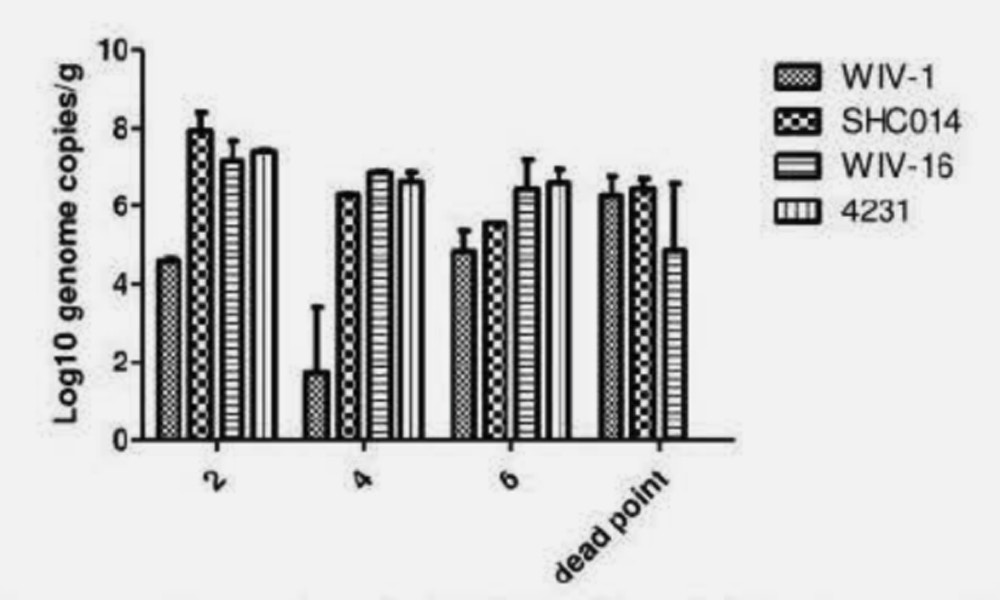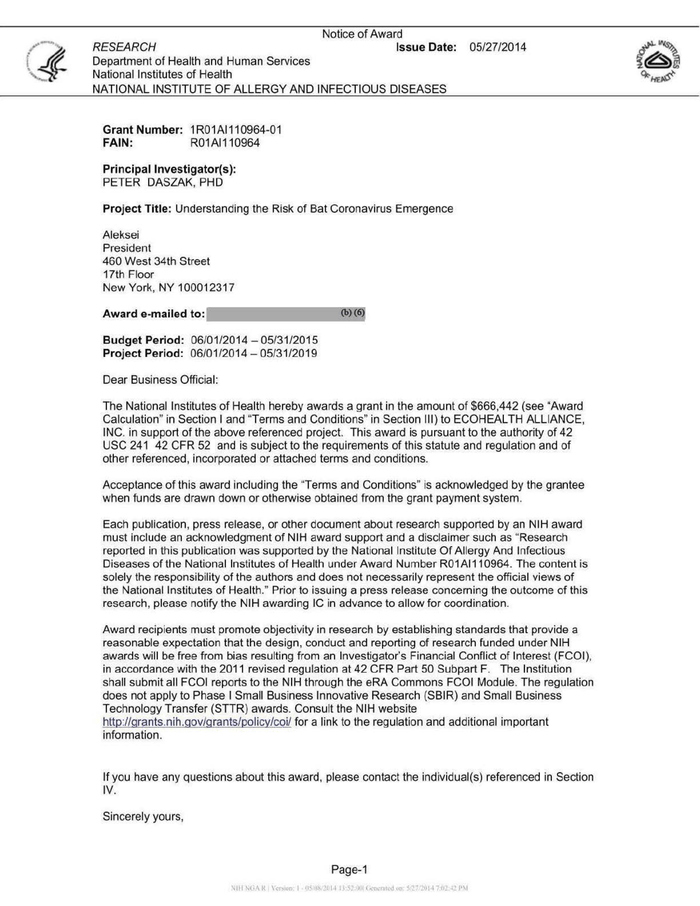Stalin said “When we hang the capitalists they will sell us the rope we use.” In this case we gave them the money for the rope
The Wuhan Institute of Virology and the nearby Wuhan University Center for Animal Experiment, along with their collaborator, the U.S.-based nonprofit EcoHealth Alliance, have engaged in what the U.S. government defines as “gain-of-function research of concern,” (Genetic Modification) intentionally making viruses more pathogenic or transmissible in order to study them. Grant money for the controversial experiment came from the National Institutes of Health’s National Institute of Allergy and Infectious Diseases, which is headed by Anthony Fauci. The award to EcoHealth Alliance, a research organization which studies the spread of viruses from animals to humans, included subawards to Wuhan Institute of Virology and East China Normal University. The principal investigator on the grant is EcoHealth Alliance President Peter Daszak, who has been a key voice in the search for Covid-19’s origins.
Several scientists said the NIH recently released documents points to biosafety concerns, highlighting a general lack of oversight for research on pathogens and raising questions about what other information has not been publicly disclosed.
“As a virologist, I personally think creating chimeras of SARS-related bat coronaviruses that are thought to pose high risk to humans entails unacceptable risks,” said Jesse Bloom, who studies the evolution of viruses at the Fred Hutchinson Cancer Research Center. Severe acute respiratory syndrome, or SARS, is a disease caused, like Covid-19, by an airborne coronavirus.

National Institute of Allergy and Infectious Diseases Director Anthony Fauci listens during a briefing on the coronavirus pandemic at the White House on March 26, 2020, in Washington, D.C.
The researchers reported, “These results demonstrate varying pathogenicity of SARSr-CoVs with different spike proteins in humanized mice.”But the terms of the grant clearly stipulated that the funding could not be used for gain-of-function experiments. The grant conditions also required the researchers to immediately report potentially dangerous results and stop their experiments pending further NIH review.
According to both the EcoHealth Alliance and NIH, the results were reported to the agency, but NIH determined that rules designed to restrict gain-of-function research did not apply.
Seven consulted scientists who are virologists or work in adjacent fields and hold a range of views on both the ethics of gain-of-function research and the Covid-19 origins search. said that the work appears to meet NIH’s criteria for gain-of-function research. Three experts said that, while they did not have enough knowledge of U.S. policies to comment on whether the research met NIH criteria, the experiment involving humanized mice was unnecessarily risky. One virologist, Vincent Racaniello, a professor of microbiology and immunology at Columbia University, said while he considered the mouse experiment described in the document to clearly fall into the gain-of-function category.
NIH grant for research titled:
Understanding-Risk-Bat-Coronavirus-Emergence-Grant-Notice link below 528 pages
But the group’s bat coronavirus research was focused on the very threat that bat viruses pose to people. Kessler did acknowledge that, while the original bat coronavirus in the experiment did not spread among humans, the research was designed to gauge how bat coronaviruses could evolve to infect humans. Scientists consulted agreed that, whatever title it is given, the newly public experiment raised serious concerns about the safety and oversight of federally funded research. “In my point of view, the debate about the definition of ‘gain-of-function’ has been too much focused on technical aspects,” said Jacques van Helden, a professor of bioinformatics at Aix-Marseille Université. “The real question is whether or not research has the potential to create or facilitate the selection of viruses that might infect humans.” The experiments described in the proposal clearly do have that potential, he said.
NIH spokesperson Elizabeth Deatrick said that the agency had considered the research — and decided not to restrict it under its own rules. “In 2016, NIAID determined that the work was not subject to the Gain-of-Function (GoF) research funding pause and the subsequent HHS P3CO Framework,” Deatrick wrote, referring to criteria put in place in 2017 to guide the agency’s funding decisions about research that involves, or is reasonably anticipated to involve, potential pandemic pathogens.
Paul accused Fauci of lying when he claimed that NIH did not fund gain-of-function research at the Wuhan Institute of Virology. Experts now say that the documents support the contention that NIH funded gain-of-function work, “There’s no question,” said Racaniello, of Columbia University, who pointed to the decreased weight of the mice infected with the chimeric viruses that was described in the research summaries sent to NIH. “From the weight loss, it’s gain of function. Tony Fauci is wrong saying it’s not.”
The humanized mouse experiment fits with the overall goal of the $3.1 million grant, which was titled “Understanding the Risk of Bat Coronavirus Emergence” and aimed at preventing a pandemic by predicting the circumstances under which a bat coronavirus could evolve to infect humans. The researchers took an ambitious three-pronged approach: screening people with high exposure to wildlife, mathematical modeling, and lab experiments on viruses. Peter Daszak, the EcoHealth Alliance president, has worked closely with scientists in China for years, and roughly $750,000 of the grant was allocated for the Wuhan Institute of Virology. An additional nearly $300,000 went to East China Normal University, where researchers did field sampling.
In a 2005 paper, Daszak’s team showed that the first SARS virus originated in bats. Middle East respiratory syndrome, or MERS, is caused by a coronavirus that emerged in 2012 and also believed to come from bats, which are now a prime target for virologists trying to understand and combat emerging diseases. Daszak has long maintained that his research is critical to preventing outbreaks.
The research on the bat viruses in Wuhan showed that infecting live animals with altered viruses can have unpredictable consequences. A report to NIH on the project’s progress in the year ending in May 2018 described scientists creating new coronaviruses by changing parts of WIV1 and exposing genetically engineered mice to the new chimeric viruses.
Research published in 2017 in the journal PLOS Pathogen showed that, in cells in a laboratory, similar chimeric viruses reproduced less effectively than the original. NIH cited that research as one of the reasons the moratorium on gain-of-function research of concern didn’t apply to this experiment. “It was a loss of function, not a gain of function,” the email from NIH explained.
(NIH also pointed out that the changes to the chimeric viruses “would not be anticipated to increase virulence or transmissibility in humans.”) Nick Bit: They sure as shit got that one wrong!!
Inside the lungs of the humanized mice, however, the novel viruses appear to have reproduced far more quickly than the original virus that was used to create them, according to a bar graph shown in the documents. The viral load in the lung tissue of the mice was, at certain points, up to 10,000 times higher in the mice infected with the altered viruses than in those infected with WIV1.
over to humans and cause widespread disease.”
Scientists reviewing research said the jump in viral load indicated that the modified RNA virus could replicate far more rapidly than the original in the lungs of the mice, likely leading to increased pathogenicity and spread. Another figure in the documents suggests that at least one of the altered viruses not only enhanced viral reproduction, but also caused the humanized mice to lose more weight than those exposed to the original virus — a measure of the severity of illness.

A graph from a report on NIH-funded research in Wuhan shows viral load in lung tissues of humanized mice.
“The contents of the grants raise serious questions about the review processes and oversight relating to risky pathogen research,” said Alina Chan, a Boston-based scientist. Nick Note: Of course the Covid19 virus was enhanced if not created at the Wuhan lab, See for yourself, NIH funding document below…
